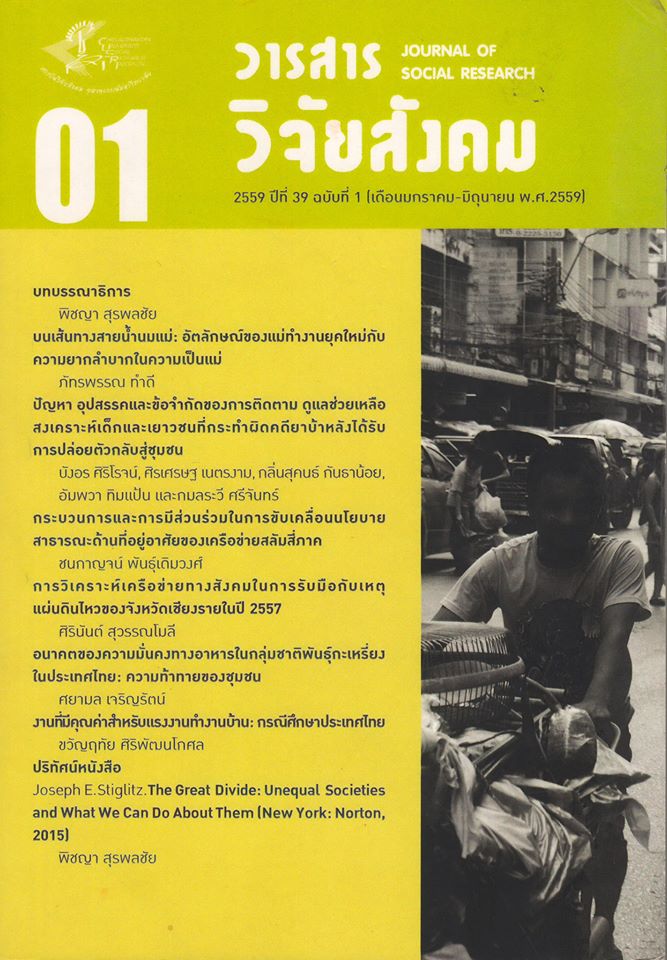กระบวนการและการมีส่วนร่วมในการขับเคลื่อนนโยบายสาธารณะด้านที่อยู่อาศัยของเครือข่ายสลัมสี่ภาค
Main Article Content
บทคัดย่อ
งานวิจัยนี้มีวัตถุประสงค์เพื่อ 1) ศึกษาให้เห็นถึงกระบวนการขับเคลื่อนนโยบายสาธารณะด้านที่อยู่อาศัยของเครือข่ายสลัมสี่ภาค 2) ศึกษาให้เห็นถึงระดับการมีส่วนร่วมของสมาชิกเครือข่ายสลัมสี่ภาคต่อการขับเคลื่อนนโยบายสาธารณะด้านที่อยู่อาศัย โดยงานวิจัยนี้ใช้เทคนิควิธีการวิจัยแบบผสมผสาน (mixed method) ทั้งวิจัยเชิงปริมาณและวิจัยเชิงคุณภาพ สถิติที่ใช้ในการวิเคราะห์ผลข้อมูล ได้แก่ การคำนวณค่าร้อยละ (Percentage) ค่าเฉลี่ย (Mean) และส่วนเบี่ยงเบนมาตรฐาน (Standard Deviation) ผลการศึกษาพบว่า กระบวนการในการขับเคลื่อนนโยบายสาธารณะของเครือข่ายสลัมสี่ภาค มีแนวทางดังนี้ 1) รวมกลุ่มเพื่อต่อรองเชิงนโยบาย คือ การประสานชุมชนต่างๆ ของเครือข่ายสลัมสี่ภาคเพื่อเปิดการเจรจาต่อรองทางนโยบายกับฝ่ายการเมือง หรือหน่วยงานต่างๆ ที่เกี่ยวข้อง โดยมีรูปแบบที่สำคัญ คือ ใช้การรวมตัวกันจัดการชุมนุม เดินขบวน ยื่นข้อเรียกร้อง เพื่อให้เกิดการแก้ไขปัญหา โดยมีข้อเสนอคือจัดตั้งเป็นคณะทำงานขึ้นมาร่วมกันระหว่างตัวแทนเครือข่ายฯ ภาครัฐ และผู้ที่เกี่ยวข้อง เพื่อดำเนินการติดตามและให้มีการแก้ไขปัญหา 2) การทำโครงการรูปธรรมเพื่อเสนอแนวทางเลือกใหม่ให้รัฐ 3) การสร้างพื้นที่ทางสาธารณะ 4) เข้าร่วมกับขบวนการภาคประชาชน รณรงค์ในประเด็นต่างๆ รวมทั้งนโยบายสาธารณะที่สำคัญ ด้านระดับการมีส่วนร่วมของสมาชิกเครือข่ายสลัมสี่ภาคต่อการขับเคลื่อนนโยบายสาธารณะด้านที่อยู่อาศัยพบว่าระดับการมีส่วนร่วมของสมาชิกเครือข่ายสลัมสี่ภาคต่อการขับเคลื่อนนโยบายสาธารณะด้านที่อยู่อาศัย ในภาพรวมอยู่ในระดับมากซึ่งสอดคล้องและเป็นไปในทิศทางเดียวกันเมื่อไปพิจารณาเป็นรายขั้นและรายข้อ คือ เมื่อพิจารณาในรายขั้นพบว่า ขั้นที่กลุ่มตัวอย่างมีระดับการมีส่วนร่วมมากที่สุดคือ ขั้นพัฒนาประเด็นสาธารณะ รองลงมาคือ ขั้นติดตามการผลักดันข้อเสนอเชิงนโยบายสู่การปฏิบัติ และขั้นที่กลุ่มตัวอย่างมีระดับการมีส่วนร่วมน้อยที่สุดคือ ขั้นจัดทำข้อเสนอเชิงนโยบาย สำหรับในรายข้อพบว่าข้อที่เครือข่ายสลัมสี่ภาคมีระดับการมีส่วนร่วมมากที่สุดคือ นำเสนอประเด็นปัญหาด้านที่อยู่อาศัยในชุมชนของตัวเอง การเข้าร่วมประชุมเพื่อหาข้อสรุปในนโยบายสาธารณะด้านที่อยู่อาศัยที่สมควรผลักดัน และการเข้าร่วมเคลื่อนไหวชุมนุมเพื่อนำเสนอข้อเรียกร้องและติดตามการแก้ปัญหา งานวิจัยนี้มีข้อเสนอแนะดังนี้ 1) ควรมีการศึกษาการขับเคลื่อนนโยบายสาธารณะและวัดระดับการมีส่วนร่วมของสมาชิกในองค์กรภาคประชาชนเพิ่มมากขึ้นเพื่อประโยชน์ในการขยายขอบเขตนโยบายสาธารณะศึกษา และ 2) ควรมีการศึกษาเปรียบเทียบการขับเคลื่อนนโยบายสาธารณะขององค์กรภาคประชาชนต่างๆ และควรขยายมุมมองในการศึกษาเพิ่มเติมถึงทัศนคติของรัฐที่มีต่อการขับเคลื่อนนโยบายสาธารณะของประชาชนด้วย
Four Regions Slum Network’s Process and Participation in Public Policy Advocacy on Housing
This research has the following aims: 1) to study and elucidate the process of public policy advocacy on housing of Four Regions Slum Network (FRSN); and 2) to study and elucidate the level of participation of FRSN members in public policy advocacy on housing. This research used mixed methods, including quantitative and qualitative methods. The statistics applied to analyze the data include percentage, mean, and standard deviation. The study found that the public policy advocacy process of FRSN had the following approaches: 1) forming a group for bargaining on policy, meaning coordinating among various member communities in order to open up policy negotiations with political power holders or relevant state agencies, whereby the important format is to use collective action in demonstrating, marching, and submitting demands in order to solve problems with the proposal of setting up a joint working group among representatives of the network, the state sector, and other relevant parties in order to implement the tracking and resolution of the problem; 2) carrying out concrete projects in order to propose new alternatives to the government; 3) creating public space; 4) joining together with the people’s movement to campaign on various issues, including important public policy. In regard to the level of participation of FRSN members in public policy advocacy on housing, the study found that overall, the level of participation of FRSN members in public policy advocacy on housing was high. This finding was in line with considerations of the individual stages and individual points. When individual stages were considered, it was found that the stage in which the sample group had the highest level of participation was developing public issues. The sample group had the second highest level of participation in the stage of following up on advocacy for policy proposals as they were implemented in practice. The stage in which the sample group had the lowest level of participation was in drafting policy proposals. In regard to the individual points, it was found that the points on which FRSN had the highest level of participation were presenting housing problems in their own communities, participating in meetings to come up with conclusions on public policy relating to housing that were worth advocating for, and joining in mobilizations/demonstrations in order to present demands and follow up on solving problems. This research has the following recommendations: 1) there should be further studies of public policy advocacy and measurement of the level of participation of members of people’s organizations for the purpose of expanding the margins of public policy studies; and 2) there should be comparative studies of public policy advocacy conducted by various people’s organizations, and study perspectives should be expanded to include state attitudes toward public policy advocacy undertaken by the people.
Article Details
1) บทความนี้เป็นลิขสิทธิ์ของสถาบันวิจัยสังคม จุฬาลงกรณ์มหาวิทยาลัย แต่ความคิดเห็นและเนื้อหาเป็นของผู้แต่ง
2) ทัศนะและความคิดเห็นที่ปรากฏในบทความในวารสารวิจัยสังคมและปริทัศน์ สถาบันวิจัยสังคม จุฬาลงกรณ์มหาวิทยาลัย ถือเป็นความรับผิดชอบของผู้แต่งบทความนั้น และไม่ถือเป็นทัศนะและความรับผิดชอบของกองบรรณาธิการวารสารวิจัยสังคมและปริทัศน์ สถาบันวิจัยสังคม จุฬาลงกรณ์มหาวิทยาลัย กองบรรณาธิการไม่สงวนสิทธิ์ในการคัดลอก แต่ให้ระบุถึงการอ้างอิง


